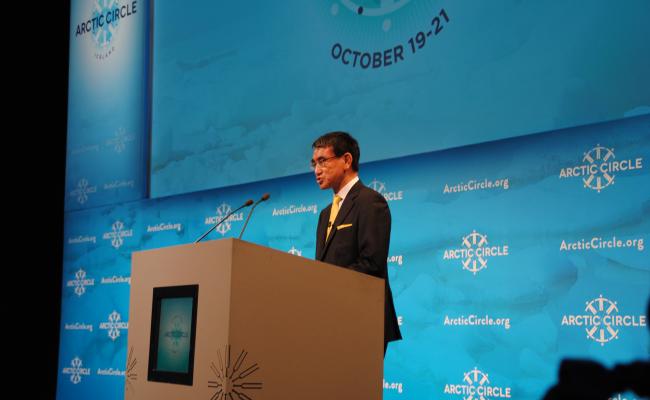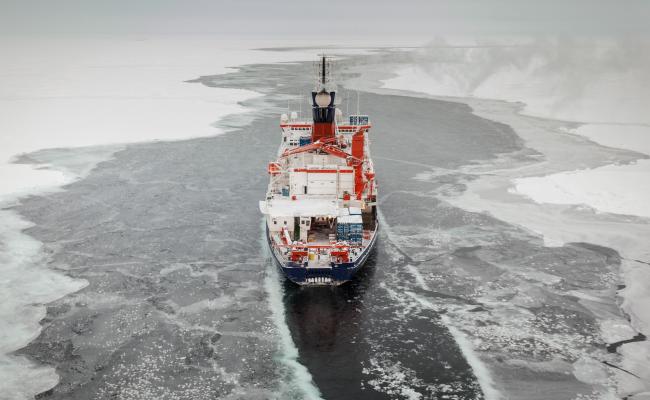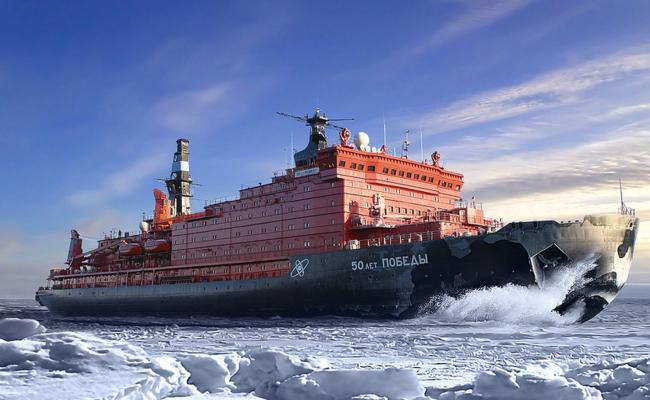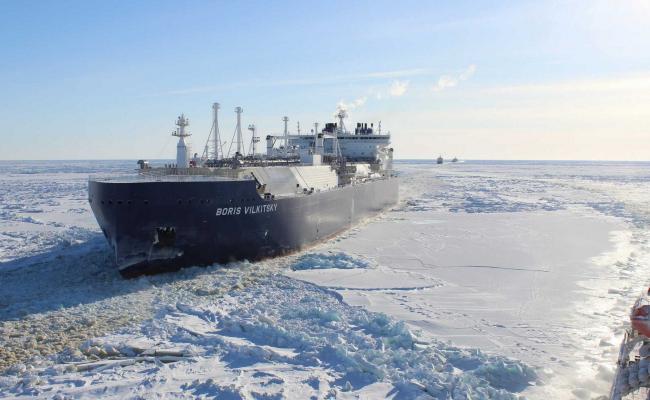Economic Interests May Trump Shipping Safety as Russia Seeks to Reduce Ice-Class Requirements
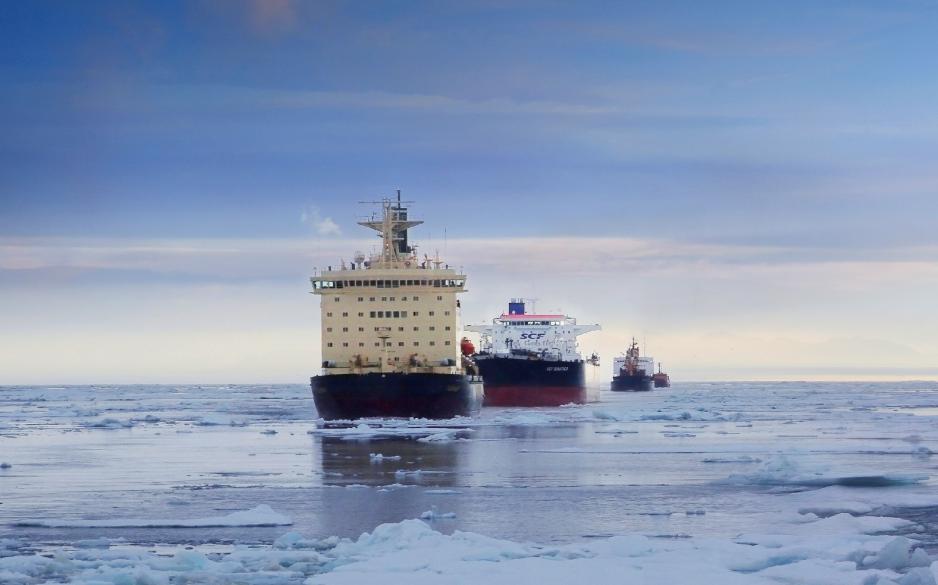
Rosatomflot icebreaker escorting a convoy of vessels through the icy waters of the Northern Sea Route. Source: (Courtesy of Rosatomflot)
The Russian Ministry of Transport has proposed a significant softening of ice-class requirements on the Northern Sea Route. The change, proposed to go into effect in May 2019, would benefit the country’s largest independent natural gas producer Novatek. The company operates the vast Yamal LNG facility and relies on the route to export its cargo.
Currently only vessels of higher ice classification, Arc7 or above, are allowed to navigate on the route during winter. Novatek, however, faces a shortage of these expensive-to-build and operate vessels and supplements its fleet with a number of lower ice-class vessels during the summer and fall.
Under the proposed change these Arc4 and Arc5 vessels, currently prohibited from operating on the route beyond November 30, could travel on the Northern Sea Route (NSR) with icebreaker escort even during the winter months.
The economics of shipping safety
The Ministry quotes the negative economic impact of the current regulation as the key reason for the proposed change.
“The non-admission of vessels with lower ice-classification to areas of favorable ice conditions results in increased cargo travel time and interrupts the workflow of transport vessels [primarily LNG carriers] to the NSR seaport in Sabetta,” according to the draft regulation.
Thus, pressure from Novatek may be the primary impetus to reduce ice-class requirements.
Russia is choosing short-term economics over shipping safety and environmental protection.
Critics point out that the current regulations, which have existed for more than a decade, are key to ensuring safety of navigation on the route.
“By watering down its regulations on the Northern Sea Route to address the current shortfall in Arc7 vessels, the Russian government is choosing short-term economics over shipping safety and environmental protection, and thereby taking risks that it previously – and wisely – chose not to take,” explains Michael Byers Professor and Canada Research Chair in Global Politics and International Law at the University of British Columbia.
Similarly, some of Russia’s partners in Arctic shipping are cognizant of the dangers of increased Arctic shipping. As HNN previously reported, Japan’s Foreign Minister highlighted a vessel navigation support system, called Venus, which can provide destination-specific information on sea ice conditions.
Less ice, more safety?
The Ministry of Transport argues that ice conditions are changing and that some parts of the route are now more accessible than they were even a decade ago. Declining sea ice coverage, however, does not necessarily result in a less challenging navigational environment, experts say.
"Ice conditions may become more unpredictable as sea ice, including growlers and bergy bits – small and medium ice fragments – is moving in a more ad-hoc manner," explains Simon Walmsley, Sr. Specialist Arctic Sustainable Development, for WWF’s Arctic Programme.
Also read
Furthermore, the fact that the proposed changes would primarily affect winter operations weakens the Ministry’s line of reasoning.
“It is difficult to justify this change as even though the NSR is more ice free in summer, ice conditions and conditions generally remain incredibly challenging in winter,” says Walmsley.
A number of incidents and near-misses, even under the more stringent standards, underline the dangers related to reducing safety standards.
And conditions are not only severe during winter. The western part of the NSR, which is of importance to Novatek to maintain access to its Yamal LNG facility faced the harshest ice in more than a decade and nuclear icebreakers had to extend their operating season to escort even Arc7 LNG carriers during the early summer of 2018.
Enforcement of rules is lacking
The Rules of Navigation for the NSR outline what ice-class vessels are allowed to navigate on each of the seven sections of the route during what time of the year, in what ice conditions, and with or without icebreaker escort.
Such lack of enforcement does not bode well for safety.
Officials suggest that by splitting the NSR into 28 sections more precise regional ice conditions can be established and will “allow for extending navigation through the NSR to vessels with weaker ice-classification.”
A more precise definition of ice conditions by regions may on paper allow for better access while maintaining safety margins. The Northern Sea Route Administration (NSRA), part of the Ministry of Transport, however, has very little power to enforce rules on the route and recorded hundreds of ice-class violations between 2015-2017.
Simply put, hundreds of vessels of the Arc4 and Arc5 category entered waters they were not allowed to be in and did not face any sanctions. Such lack of enforcement does not bode well for safety under the proposed regulation, which will result in larger numbers of less ice-capable vessels on the route.
What would be required are full and proper voyage-based risk assessments.
“These should take into account increased traffic, changing conditions, increasing violations/incidents and mitigation measures over a significant time period,” states Walmsley.
He emphasizes the need for transparency in the process, establishing clear criteria, and a science-based justification for the change in regulation.
Also read
In a sign of things to come and the political pressure the NSRA faces, it stopped publishing violations all together in 2018 after recording nearly 100 of them during 2017 alone. With the proposed change in regulation, more than half of the violations recorded between 2014-2017, would no longer "exist."
Critics ask if this is a case of making regulation to fit the needs of businesses along the route.
“The Yamal LNG and subsequent LNG projects in the region are high priority, not only for Novatek but also for Russia, and there is a perceived fear of lack of ice breaking LNG carriers,” expands Arild Moe, Senior Research Fellow at the Fridtjof Nansen Institute.
Dispute over LNG carrier
In the spring of 2018 the Boris Vilkitsky, one of the LNG carriers transporting LNG for Novatek, usually a highly ice-capable Arc7 vessel, was temporarily downgraded to an Arc4 due to a failure of its bow thrusters. As HNN reported, this resulted in a dispute between the NSRA and Ministry of Transport on one hand and Novatek and Rosatomflot on the other hand.
The former detained the vessel for a short period while the latter argued that even with a reduced classification of Arc4 the vessel was capable and it was safe to navigate.
Since this incident Novatek and Rosatomflot have exerted pressure on the Ministry of Transport to overhaul the Rules of Navigation and clarify responsibilities for ship operators and icebreaker operators, and possibly relax ice-class requirements.
They guide and limit future actions.
In the case of the Boris Vilkitsky, the vessel’s captain had failed to inform the captain of the escort icebreaker that its ice-class had been reduced. This placed Rosatomflot, the provider of icebreaking services, in the middle of the conflict between Novatek and the NSRA.
The proposed regulation would establish “mutual responsibility of the captains of ships and icebreakers.” Captains of ships under escort would be required to inform the icebreaker about the vessel’s limitations or malfunctions and in turn icebreaker captains would be responsible for assessing the ice conditions and ensuring the safety of the vessel he or she is escorting.
Experts doubt that such a system is feasible and sufficient for the challenging waters of the NSR. While the new regulation would offer more flexibility in terms of localized ice conditions, it would also place a larger burden on the captains on vessels to ensure safety and would require them to assess safety requirements in real time, rather than following established universally-applicable guidelines.
The Boris Vilkitsky incident highlights how current regulations stand in the way of Russia’s goal to rapidly develop and export hydrocarbon resources along the NSR.
“The only justification for rules and regulations is that they guide and limit future actions, even when this later becomes inconvenient,” concludes Byers.
It appears the existing Rules of Navigation on the NSR have indeed become inconvenient.


